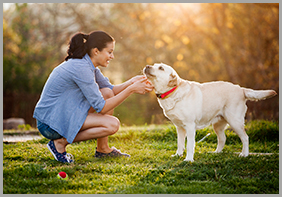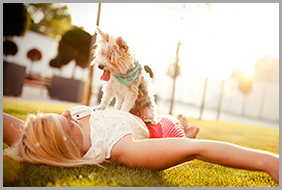 It is well-accepted that dogs benefit from regular exercise which, for many canines, can be as unpretentious as one or two daily walks in the park or around their neighbourhood. Luckily, most dogs delight in going for walks, if for no other purpose than it is an activity that aligns with their inherent instincts to explore their surroundings (i.e.: to sniff); this generally means that most dog owners do not have to repeatedly ask their dogs whether they are ready to go for their walk – once is usually sufficient.
It is well-accepted that dogs benefit from regular exercise which, for many canines, can be as unpretentious as one or two daily walks in the park or around their neighbourhood. Luckily, most dogs delight in going for walks, if for no other purpose than it is an activity that aligns with their inherent instincts to explore their surroundings (i.e.: to sniff); this generally means that most dog owners do not have to repeatedly ask their dogs whether they are ready to go for their walk – once is usually sufficient.
Of course, dog walks do not come without various distractions; on any given walk, a dog and its owner might need to deal with:
Consequently, to fully enjoy these strolls, dog owners are encouraged to train their pets to respect and abide by the basic obedience commands, including how to walk on a leash without pulling toward or away from any such diversions. This tends to make the walks more relaxed and adds a measure of safety for both parties; some of the latter relates to averting the potential harm that can occur if a dog is left off its leash and runs away.
While taking such precautions is admirable, not to mention responsible dog ownership, it remains contrary to the intrinsic disposition of many breeds; that is, to have the freedom to run and sniff and investigate without being restricted by the length of a leash. Stated another way, the most rewarding type of walk for a dog is that which is done off-leash.
Before discussing any elements specific to off-leash dog training, it is important to bear in mind that this approach might not be suitable for all types of dogs, particularly those bred to chase prey or follow scents (like hounds, for example). On the other hand, there are several dog breeds that can and do respond well if trained to walk off-leash, such as (in alphabetical order):
Along with the choice of breed, another key factor to note about off-leash dog training is that it cannot be accomplished quickly or with sporadic amounts of attention and effort; it requires a significant commitment of time and energy on the part of the dog owner.
With the above base in place, here are some tips on how to train a dog to walk off-leash:
With the appropriate investment of effort, repetition, and patience, an owner can indeed establish the trust needed to walk their dog freely without the use of a leash.
 While off-leash training can strengthen the trust between a dog and its owner, time may be the greatest deterrent to achieving the desired level of success. Let’s face it; people must attend to several priorities every day and there are only so many hours available to address them.
While off-leash training can strengthen the trust between a dog and its owner, time may be the greatest deterrent to achieving the desired level of success. Let’s face it; people must attend to several priorities every day and there are only so many hours available to address them.
As mentioned above, off-leash dog training cannot be an off-and-on activity; its success requires a concentrated effort and a considerable investment of time, by both the owner and the dog. Fortunately, for those owners who want to train their dog to walk off-leash but are concerned about their capacity to dedicate their time to such an endeavour, they have the option to use a professional dog training service like Alpha Paws in Newmarket.
Alpha Paws offers off-leash dog training in two formats to meet the needs and personal schedules of their clients:
For further information on the minimum requirements for participation in these programs and/or their content/structure, visit
Interested in learning how you can walk your dog without a leash? Call the experienced dog trainers from Alpha Paws today at 647-694-4584 to discuss our off-leash training programs and determine the best option for you and your dog.
Also Read: